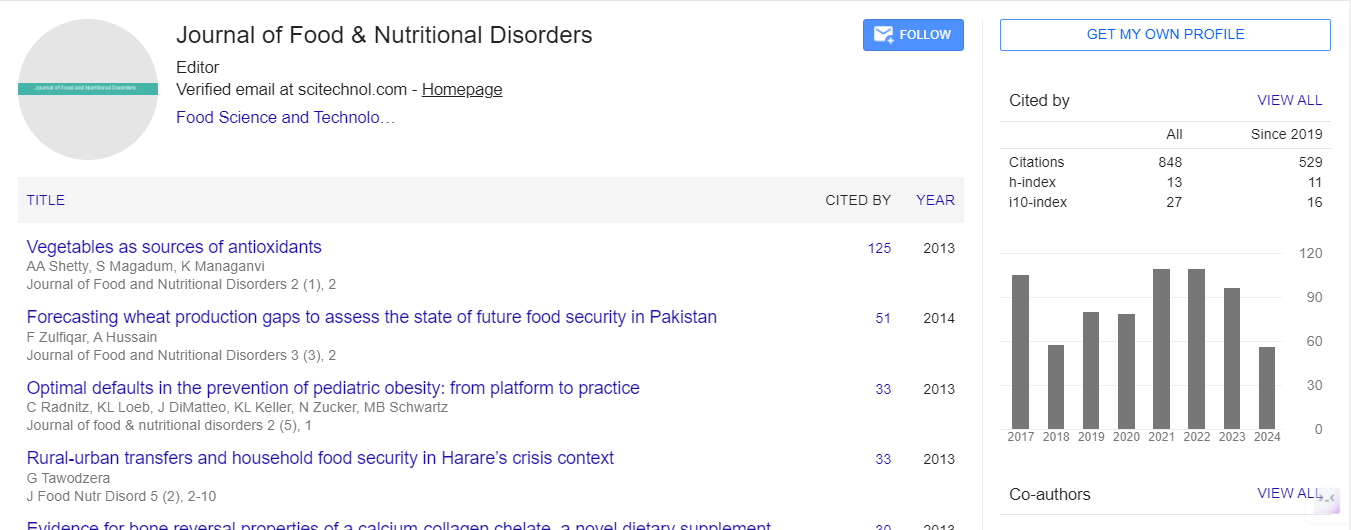Commentary, J Food Nutr Disor Vol: 13 Issue: 6
Longitudinal Study of Relapse Rates in Patients with Anorexia Nervosa and Bulimia Nervosa
Rachel Li*
1Department of Food Science and Human Nutrition, Michigan State University, East Lansing, MI, USA
*Corresponding Author: Rachel Li,
Department of Food Science and Human Nutrition,
Michigan State University, East Lansing, MI, USA
E-mail: rachelli@yahoo.com
Received date: 25 November, 2024, Manuscript No. JFND-24-156721;
Editor assigned date: 27 November, 2024, PreQC No. JFND-24-156721 (PQ);
Reviewed date: 13 December, 2024, QC No. JFND-24-156721;
Revised date: 20 December, 2024, Manuscript No JFND-24-156721 (R);
Published date: 30 December, 2024, DOI: 10.4172/2324-9323.1000442.
Citation: Li R (2024) Longitudinal Study of Relapse Rates in Patients with Anorexia Nervosa and Bulimia Nervosa. J Food Nutr Disor 13:6.
Description
The Eating disorders, particularly Anorexia Nervosa (AN) and Bulimia Nervosa (BN), are complex psychological conditions characterized by severe disturbances in eating behaviors and body image. Both disorders can lead to significant physical and psychological impairments, and understanding the course and prognosis of these conditions is critical for developing effective treatment strategies. Relapse rates in patients recovering from AN and BN have been a focal point of research, as many individuals experience recurring symptoms even after periods of remission. This paper outlines the significance of conducting a longitudinal study to investigate the relapse rates among patients with AN and BN, focusing on the implications for treatment and recovery. A longitudinal study design can be particularly useful for tracking the progression of eating disorders over time. In such studies, researchers select a cohort of patients diagnosed with AN and BN and follow them over several years. Data collection methods can include structured interviews, psychological assessments, and self-report questionnaires regarding eating behaviors and psychological health. Through repeated measures at specified intervals, researchers can assess the rates of relapse and identify factors that contribute to both recovery and relapse. Existing literature indicates that relapse rates for both AN and BN can be alarmingly high. Studies suggest that approximately 30%-50% of individuals who achieve remission from AN experience a relapse within a year, while a staggering 50%-75% of individuals with BN may relapse within the same time frame. These statistics speak to the chronic nature of eating disorders and the difficulties patients face in maintaining recovery.
Longitudinal research has revealed critical insights into the timing of relapses. Relapse often occurs shortly after treatment has ended, suggesting that the transition from a structured therapeutic environment to independent living poses challenges for patients. Many individuals report feeling unprepared to navigate the complexities of daily life without the support they received during treatment. A range of factors has been identified that could influence relapse rates in individuals with AN and BN. These include psychological factors such as co-occurring mental health disorders (e.g., depression, anxiety), personality traits (e.g., perfectionism, impulsivity), and maladaptive coping mechanisms. Additionally, environmental factors, including family dynamics, peer influences, and life stressors, play a important role in the likelihood of relapse. For example, a toxic home environment may exacerbate symptoms, while supportive family relationships can foster resilience and recovery.
Moreover, biological factors, such as genetic predispositions and neurochemical imbalances, are also implicated in the susceptibility to relapse. Research indicates that certain individuals may have a genetic vulnerability that affects their emotional regulation and response to stress, influencing their ability to maintain recovery. The findings from longitudinal studies on relapse rates highlight the need for comprehensive treatment approaches that extend beyond short-term intervention. Effective treatment plans must incorporate ongoing support and monitoring to prevent relapse. This could include regular follow-up appointments with mental health professionals, involvement in support groups, and psychoeducation for both patients and their families.
Additionally, the integration of relapse prevention strategies into the therapeutic process is critical. Cognitive-Behavioral Therapy (CBT), for instance, has been shown to be effective in identifying and modifying harmful thought patterns and behaviors that contribute to relapse. Skills training in emotional regulation and coping strategies is also essential for equipping patients to handle triggers and high-risk situations once they leave formal treatment.
Longitudinal studies of relapse rates in patients with Anorexia Nervosa and Bulimia Nervosa provide valuable insights into the ongoing challenges faced by individuals in recovery. The high relapse rates underscore the chronic nature of these disorders and the necessity for continuous support and innovative treatment strategies. By understanding the factors associated with relapse, treatment providers can develop more effective interventions that address not only the symptoms of eating disorders but also the underlying psychological, environmental, and biological influences. Ultimately, a multifaceted approach that emphasizes long-term care and resilience-building is essential to improve the prognosis for individuals struggling with AN and BN.
 Spanish
Spanish  Chinese
Chinese  Russian
Russian  German
German  French
French  Japanese
Japanese  Portuguese
Portuguese  Hindi
Hindi 
